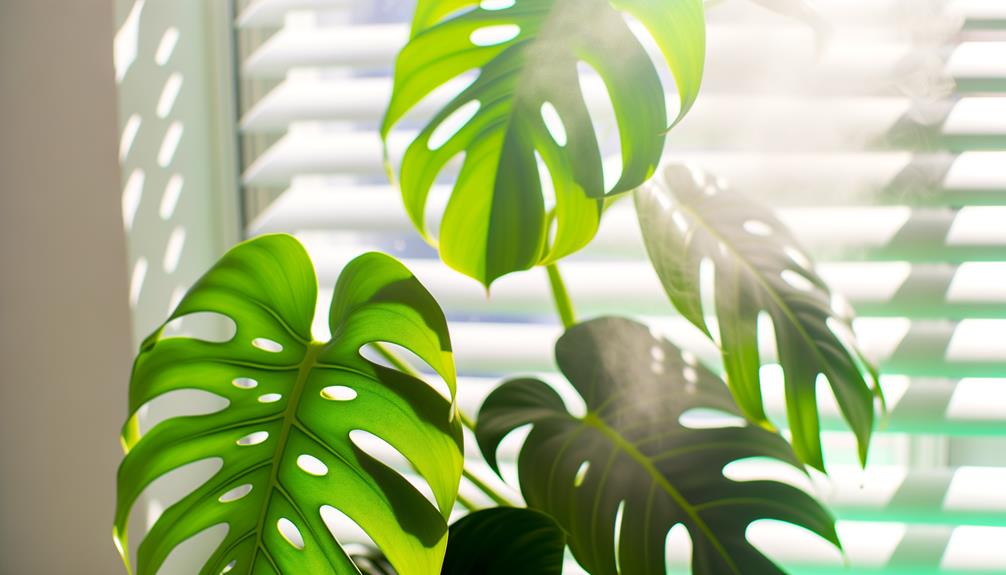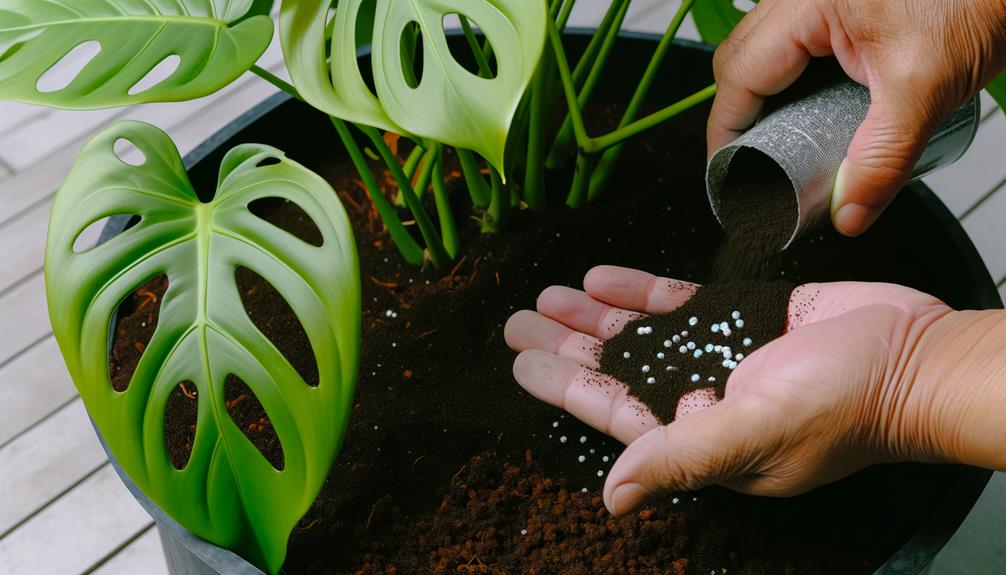Monstera Friedrichsthalii Swiss Cheese Vine: Care Guide!
Monstera Friedrichsthalii, also known as the Swiss Cheese Vine, hails from Central and South America where it was used medicinally. Its distinctive fenestrated leaves optimize light absorption and reduce water loss, enhancing photosynthetic efficiency.
This vine thrives in bright, indirect light and high humidity, preferring well-draining, nutrient-rich soil. Water thoroughly when the top inch is dry, avoiding overwatering.
Incorporate a support like a moss pole for vertical growth. With striking leaves and a climbing habit, it serves as an enchanting focal point in interior spaces.
There’s much more to learn about its care and decorative potential.

Key Takeaways
- Displays fenestrated leaves that enhance light absorption and minimize water loss.
- Thrives in bright, indirect light with high humidity and well-draining soil.
- Requires watering when the top inch of soil is dry to avoid overwatering.
- Benefits from support like trellises or moss poles for vertical growth and stability.
- Complements other plants like Philodendron Brasil and Pothos for a vibrant, balanced display.
Origins and History

Originating from the tropical rainforests of Central and South America, Monstera Friedrichsthalii, commonly known as the Swiss Cheese Vine, has a rich history intertwined with indigenous cultures and botanical exploration.
You’ll find that native tribes utilized this plant for medicinal purposes, leveraging its unique properties to treat various ailments. Botanists first catalogued it in the 19th century, fascinated by its rapid growth and distinct morphology.
It thrives in humid, shaded environments, often climbing trees to access filtered sunlight. European explorers transported specimens to botanical gardens, where it quickly became a horticultural curiosity.
Today, you can see its popularity soaring among plant enthusiasts, not just for its aesthetic appeal but also for its fascinating history and adaptability in diverse conditions.
Unique Leaf Structure
The Monstera Friedrichsthalii’s leaves display a remarkable fenestration pattern, characterized by multiple oval-shaped perforations that maximize light absorption while minimizing water loss. These strategically placed holes help you understand how the plant adapts to its natural environment.
The perforations reduce the leaf’s surface area, decreasing transpiration rates and enhancing photosynthetic efficiency. This unique structure allows for best light penetration to the lower foliage, supporting overall plant health.
Additionally, the fenestrations enable the plant to withstand physical stress from wind and rain, preventing leaf damage. The distinctive appearance also aids in camouflage, making it less noticeable to herbivores.
Ideal Growing Conditions

To cultivate Monstera Friedrichsthalii successfully, provide bright, indirect light and maintain a consistent temperature between 65-80°F. Make sure the plant is placed in a well-ventilated area to prevent fungal issues.
It thrives in high humidity, ideally 60% or higher, which mimics its natural tropical habitat. You can boost humidity with a humidifier or by placing a water tray nearby.
- Soil: Use a well-draining, nutrient-rich potting mix to support root health.
- Lighting: Avoid direct sunlight as it can scorch the leaves; filtered light is ideal.
- Support: Offer a moss pole or trellis to encourage vertical growth and aerial root development.
Pay close attention to these conditions to keep your Swiss Cheese Vine healthy and thriving.
Watering Requirements
Promoting proper watering is crucial for Monstera Friedrichsthalii, as both excessive watering and insufficient watering can lead to significant health issues. You should water the plant when the top inch of soil feels dry to the touch.
Use room-temperature water and ensure even distribution around the root zone. Avoid saturated conditions by allowing excess water to drain thoroughly.
Conversely, insufficient watering may cause the leaves to yellow and curl. Aim for a humidity level of 60-80%, as it mimics the plant’s tropical habitat. During winter, reduce watering frequency, allowing the soil to dry out more between sessions.
Monitoring soil moisture levels and adjusting your watering schedule accordingly will support optimal growth and health for your Monstera Friedrichsthalii.
Soil and Fertilization

Beyond proper watering, selecting the right soil mix and fertilization routine is essential for Monstera Friedrichsthalii’s robust growth and health. You should use a well-draining, aerated soil mix to prevent root rot and allow for adequate oxygenation.
A mix containing peat, perlite, and orchid bark works well. Fertilize during the growing season—spring and summer—using a balanced, water-soluble fertilizer every 4-6 weeks. Avoid over-fertilization to prevent nutrient burn.
- Soil Composition: Use a mix of peat, perlite, and orchid bark.
- Fertilization Frequency: Apply every 4-6 weeks during the growing season.
- Nutrient Balance: Use a balanced, water-soluble fertilizer.
Pruning and Maintenance
Regular trimming and upkeep are crucial for Monstera Friedrichsthalii to enhance its aesthetic appeal and overall well-being. Start by sterilizing your pruning shears to prevent pathogen spread. Focus on yellowing or damaged leaves initially, trimming near the stem.
For growth management, prune back excessively long vines, making sure to cut just above a node to promote denser growth. Maintain ideal humidity by misting the foliage, which helps prevent leaf dehydration. Regularly check your plant for any signs of stress or nutrient deficiencies, adjusting care routines as needed.
Keep in mind, proper trimming not only shapes the plant but also improves airflow, decreasing the likelihood of fungal infections. Consistent upkeep leads to a strong, visually attractive Monstera Friedrichsthalii.
Common Pests and Diseases

You’ll often encounter spider mite infestations, identified by webbing and stippled leaves.
Fungal leaf spots manifest as dark, irregular lesions, compromising the plant’s photosynthetic efficiency.
For mealybug control, apply insecticidal soap, ensuring thorough coverage of all plant surfaces.
Spider Mite Infestations
Spider mite infestations, characterized by tiny webbing and yellowing leaves, can compromise the health of your Monstera Friedrichsthalii to a great extent.
These minuscule arachnids feed on plant sap, weakening the foliage and stunting growth. You’ll often notice fine silk webbing on the underside of leaves and tiny puncture marks where the mites have fed.
To identify and manage spider mite infestations, consider the following:
- Regular Monitoring: Inspect your plant frequently for early signs of infestation.
- Humidity Control: Increase humidity levels, as spider mites thrive in dry conditions.
- Biological Controls: Introduce natural predators like ladybugs or predatory mites.
Effective management involves prompt action and consistent care to protect your Monstera Friedrichsthalii from these pervasive pests.
Fungal Leaf Spots
When you notice irregularly shaped, discolored spots on the leaves of your Monstera Friedrichsthalii, it’s a clear sign that fungal leaf spots are affecting your plant. These lesions often appear as small, water-soaked areas that gradually enlarge, becoming brown or black with yellow halos.
The fungi responsible thrive in warm, humid conditions, making overwatering and poor air circulation prime culprits. To combat this, immediately remove infected leaves using sterilized pruning tools. Enhance air circulation around the plant and avoid overhead watering to keep foliage dry.
Applying a fungicide, specifically one labeled for ornamental plants, can also help control the spread. By adhering to these steps, you can effectively manage and prevent further fungal infections in your Monstera Friedrichsthalii.
Mealybug Control Tips
Just as fungal infections pose a threat to your Monstera Friedrichsthalii, mealybugs represent another significant challenge that requires immediate attention.
These pests, small and covered in a white, waxy coating, can cause severe damage by sucking sap from the plant tissues. To control mealybugs effectively, you should adopt an integrated pest management approach.
- Inspect regularly: Examine your plant, especially the undersides of leaves and stem junctions, for early detection of mealybugs.
- Manual removal: Use a cotton swab dipped in rubbing alcohol to remove visible mealybugs.
- Natural predators: Introduce beneficial insects like ladybugs or lacewings that feed on mealybugs.
Decorative Uses
You can enhance your indoor aesthetic by incorporating Monstera Friedrichsthalii, known for its unique fenestrated leaves.
Utilize vertical space effectively by training the vine on trellises or moss poles, creating a striking visual element.
Pair it with complementary plants like ferns or ivy to achieve a lush, cohesive display.
Indoor Aesthetic Appeal
With its striking fenestrated leaves and climbing habit, Monstera Friedrichsthalii serves as an exceptional focal point in interior design, elevating the aesthetic appeal of any indoor space. You can integrate this plant into your decor to create a visually alluring environment.
The unique morphology of its leaves, with natural perforations, adds a dynamic texture to your room, while its climbing nature allows for versatile placement.
- Visual Interest: The plant’s unique leaf structure creates a stunning visual centerpiece.
- Air Quality: It contributes to improved indoor air quality by absorbing pollutants.
- Versatility: You can place it in various settings, from living rooms to home offices, enhancing the space’s overall design.
Incorporate Monstera Friedrichsthalii to transform your indoor aesthetic.
Vertical Space Utilization
Maximize your vertical area by training Monstera Friedrichsthalii to climb trellises or moss poles, enhancing both its growth potential and decorative appeal.
When you provide vertical structures, the plant’s aerial roots will anchor securely, promoting robust growth and best leaf fenestration. Utilize a sturdy moss pole to maintain humidity, aiding in nutrient absorption and mimicking natural habitats.
Position the plant in indirect light to guarantee photosynthesis without leaf scorching. Secure stems with soft ties to guide upward growth effectively.
Complementary Plant Pairings
Pairing Monstera Friedrichsthalii with plants like Philodendron Brasil or Pothos can create a visually harmonious indoor garden, enhancing the aesthetic appeal and biodiversity of your space. These combinations not only elevate the decorative aspect but also introduce diverse growth habits and foliage textures, contributing to a balanced micro-ecosystem.
- Philodendron Brasil: Its variegated leaves introduce a vibrant contrast, complementing the Monstera’s perforated foliage.
- Pothos: This resilient plant’s cascading vines provide a lush backdrop, enhancing the vertical dimensions of your garden.
- Fiddle Leaf Fig: Its broad, upright leaves offer structural balance, juxtaposing the Monstera’s trailing, fenestrated leaves.
Monstera Friedrichsthalii Swiss Cheese Philodendron Tropical
Monstera friedrichsthalii, commonly referred to as the Swiss Cheese Plant, is often mistaken for a Philodendron due to its similar appearance and growth habits. However, it belongs to the Monstera genus, not the Philodendron genus.
This tropical plant is native to Central and South America and thrives in warm, humid environments with indirect light. Its distinctive fenestrated leaves make it a popular choice for indoor plant enthusiasts.
Conclusion
By cultivating Monstera friedrichsthalii, you’re not just adding a plant to your collection; you’re embracing a piece of botanical history. Its unique fenestrated leaves, reminiscent of a Swiss cheese motif, demand precise care—think of it as programming an old VCR.
Guarantee ideal conditions, from watering to pruning, to maintain its health. By doing so, you’ll enjoy not only a beautiful plant but also a living marvel of evolutionary adaptation.
Happy growing!






